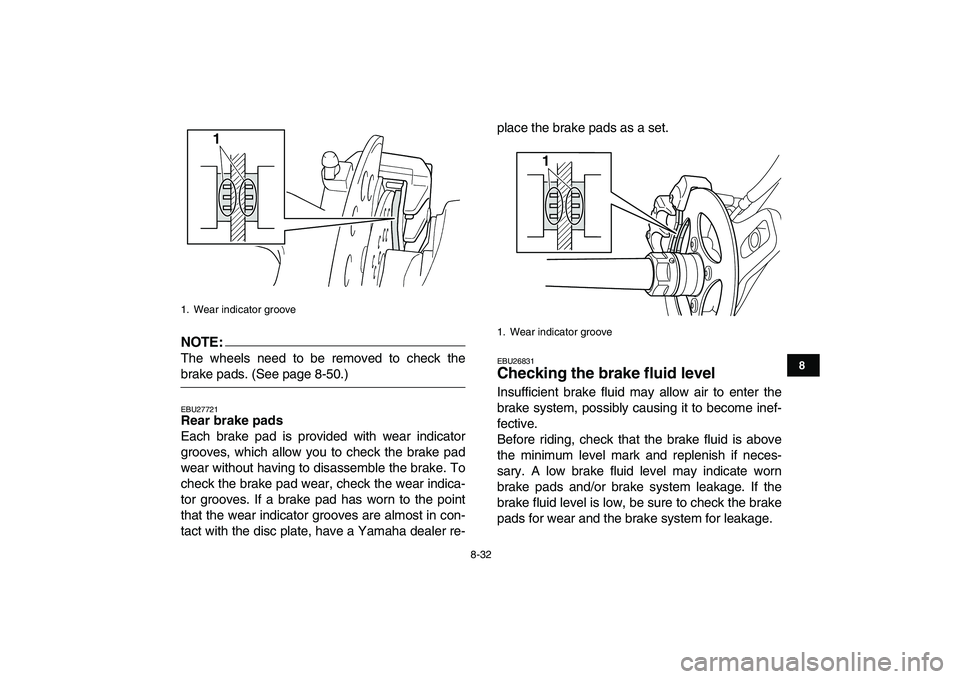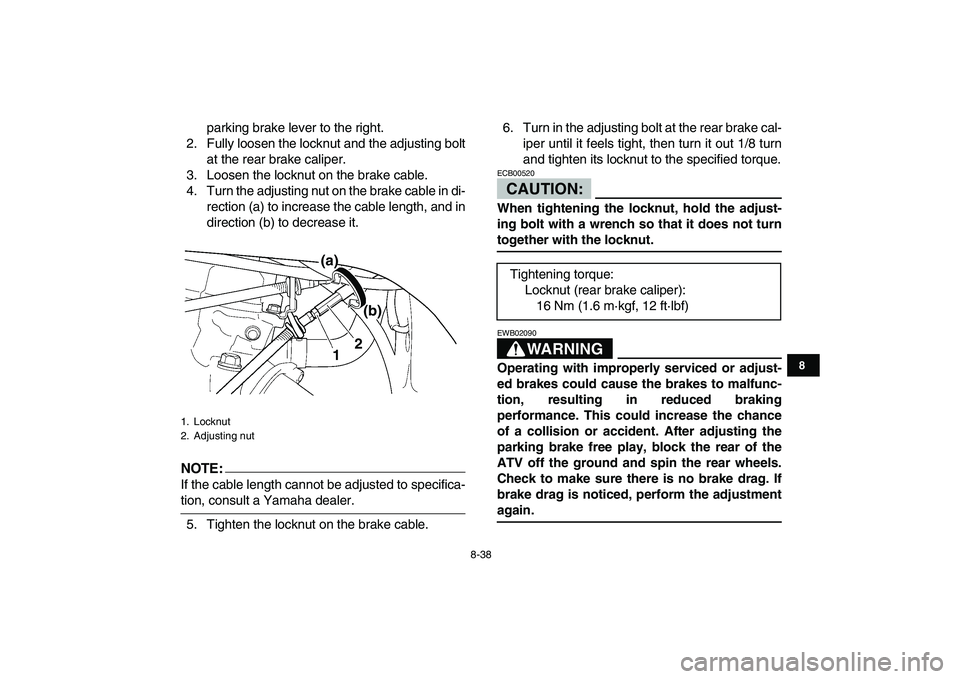Page 115 of 148

8-32
1
2
3
4
5
6
78
9
10
11
NOTE:
The wheels need to be removed to check the
brake pads. (See page 8-50.)
EBU27721
Rear brake pads
Each brake pad is provided with wear indicator
grooves, which allow you to check the brake pad
wear without having to disassemble the brake. To
check the brake pad wear, check the wear indica-
tor grooves. If a brake pad has worn to the point
that the wear indicator grooves are almost in con-
tact with the disc plate, have a Yamaha dealer re-place the brake pads as a set.
EBU26831
Checking the brake fluid level
Insufficient brake fluid may allow air to enter the
brake system, possibly causing it to become inef-
fective.
Before riding, check that the brake fluid is above
the minimum level mark and replenish if neces-
sary. A low brake fluid level may indicate worn
brake pads and/or brake system leakage. If the
brake fluid level is low, be sure to check the brake
pads for wear and the brake system for leakage.
1. Wear indicator groove
1
1. Wear indicator groove1
Page 121 of 148

8-38
1
2
3
4
5
6
78
9
10
11
parking brake lever to the right.
2. Fully loosen the locknut and the adjusting bolt
at the rear brake caliper.
3. Loosen the locknut on the brake cable.
4. Turn the adjusting nut on the brake cable in di-
rection (a) to increase the cable length, and in
direction (b) to decrease it.
NOTE:
If the cable length cannot be adjusted to specifica-
tion, consult a Yamaha dealer.
5. Tighten the locknut on the brake cable.6. Turn in the adjusting bolt at the rear brake cal-
iper until it feels tight, then turn it out 1/8 turn
and tighten its locknut to the specified torque.CAUTION:
ECB00520
When tightening the locknut, hold the adjust-
ing bolt with a wrench so that it does not turn
together with the locknut.WARNING
EWB02090
Operating with improperly serviced or adjust-
ed brakes could cause the brakes to malfunc-
tion, resulting in reduced braking
performance. This could increase the chance
of a collision or accident. After adjusting the
parking brake free play, block the rear of the
ATV off the ground and spin the rear wheels.
Check to make sure there is no brake drag. If
brake drag is noticed, perform the adjustment
again.
1. Locknut
2. Adjusting nut
(a)
(b)
12
Tightening torque:
Locknut (rear brake caliper):
16 Nm (1.6 m·kgf, 12 ft·lbf)
Page 126 of 148
8-43
1
2
3
4
5
6
78
9
10
11
EBU24931
Checking and lubricating the brake and
shift pedals
The operation of the brake and shift pedals should
be checked before each ride, and the pedal pivots
should be lubricated if necessary.
Brake pedal
EBU24962
Checking the wheel hub bearings
The front and rear wheel hub bearings must be
checked at the intervals specified in the periodic
maintenance and lubrication chart. If there is play
in a wheel hub or if a wheel does not turn smoothly,
have a Yamaha dealer check the wheel hub bear-
ings.
EBU24992
Lubricating the swingarm pivots
The swingarm pivots must be lubricated at the in-
tervals specified in the periodic maintenance and
lubrication chart. Recommended lubricants:
Brake pedal:
Silicone grease
Shift pedal:
Lithium-soap-based grease (all-purpose
grease)
Recommended lubricant:
Lithium-soap-based grease
Page 133 of 148
8-50
1
2
3
4
5
6
78
9
10
11
EBU25580
Replacing the tail/brake light bulb
If the tail/brake light bulb burns out, have a
Yamaha dealer replace it.
EBU25650
Removing a wheel
1. Loosen the wheel nuts.
FrontRear
2. Elevate the ATV and place a suitable stand
under the frame.
3. Remove the nuts from the wheel.
4. Remove the wheel.
EBU25670
Installing a wheel
1. Install the wheel and the nuts.
NOTE:
When installing a front wheel, make sure its arrow
mark points toward the rotating direction of the
wheel.
1. Nut
1. Nut
Page 134 of 148

8-51
1
2
3
4
5
6
78
9
10
11
Front
2. Lower the ATV to the ground.
3. Tighten the wheel nuts to the specified
torques.
EBU25740
Troubleshooting
Although Yamaha ATVs receive a thorough in-spection before shipment from the factory, trouble
may occur during operation. Any problem in the fu-
el, compression, or ignition systems, for example,
can cause poor starting and loss of power.
The following troubleshooting charts represent
quick and easy procedures for checking these vital
systems yourself. However, should your ATV re-
quire any repair, take it to a Yamaha dealer, whose
skilled technicians have the necessary tools, expe-
rience, and know-how to service the ATV properly.
Use only genuine Yamaha replacement parts. Im-
itation parts may look like Yamaha parts, but they
are often inferior, have a shorter service life and
can lead to expensive repair bills.
WARNING
EWB02280
Do not smoke when checking the fuel system.
Fuel can ignite or explode, causing severe inju-
ry or property damage. Make sure there are no
open flames or sparks in the area, including pi-
lot lights from water heaters or furnaces.
1. Arrow mark
Tightening torques:
Front wheel nut:
45 Nm (4.5 m·kgf, 33 ft·lbf)
Rear wheel nut:
45 Nm (4.5 m·kgf, 33 ft·lbf)
Page 137 of 148

9-1
1
2
3
4
5
6
7
89
10
11
EBU25860
CLEANING AND STORAGE
EBU25900
Cleaning
Frequent, thorough cleaning of your ATV will not
only enhance its appearance but will improve its
general performance and extend the useful life of
many components.
1. Before cleaning the ATV:
a. Block off the end of the exhaust pipe to
prevent water entry. A plastic bag and
strong rubber band may be used.
b. Make sure the spark plug and all filler caps
are properly installed.
2. If the engine case is excessively greasy, apply
degreaser with a paint brush. Do not apply de-
greaser to the chain, sprockets or wheel ax-
les.
3. Rinse the dirt and degreaser off with a garden
hose. Use only enough pressure to do the job.
CAUTION:
ECB00710
Excessive water pressure may cause water
seepage and deterioration of wheel bearings,
brakes, transmission seals and electrical de-
vices. Many expensive repair bills have result-ed from improper high-pressure detergent
applications such as those available in coin-
operated car washers.
4. Once most of the dirt has been hosed off,
wash all surfaces with warm water and mild,
detergent-type soap. An old toothbrush or bot-
tle brush is handy for hard-to-reach places.
5. Rinse the ATV off immediately with clean wa-
ter and dry all surfaces with a chamois, clean
towel or soft absorbing cloth.
6. Dry the chain and lubricate it to prevent it from
rusting.
7. Clean the seat with a vinyl upholstery cleaner
to keep the cover pliable and glossy.
8. Automotive type wax may be applied to all
painted and chrome plated surfaces. Avoid
combination cleaner-waxes. Many contain
abrasives which may mar the paint or protec-
tive finish. When finished cleaning, start the
engine and let it idle for several minutes.WARNING
EWB02310
Wet brakes may have reduced stopping ability,
Page 139 of 148
9-3
1
2
3
4
5
6
7
89
10
11
with oil.)
e. Remove the spark plug cap from the spark
plug, and then install the spark plug and
the spark plug cap.
6. Lubricate all control cables and the pivoting
points of all levers and pedals.
7. Check and, if necessary, correct the tire air
pressure, and then block up the ATV so that
all of its wheels are off the ground. Alternative-
ly, turn the wheels a little every month in order
to prevent the tires from becoming degraded
in one spot.
8. Cover the muffler outlet with a plastic bag to
prevent moisture from entering it.
9. Remove the battery and fully charge it. Store
it in a cool, dry place and charge it once a
month. Do not store the battery in an exces-
sively cold or warm place [less than 0 °C (30
°F) or more than 30 °C (90 °F)]. For more in-
formation on storing the battery, see page
8-45.
NOTE:
Make any necessary repairs before storing the
ATV.
Page 140 of 148
10-1
1
2
3
4
5
6
7
8
910
11
EBU25960
SPECIFICATIONS
EBU25975
Dimensions:
Overall length:
1840 mm (72.4 in)
Overall width:
1170 mm (46.1 in)
Overall height:
1090 mm (42.9 in)
Seat height:
810 mm (31.9 in)
Wheelbase:
1280 mm (50.4 in)
Ground clearance:
255 mm (10.0 in)
Minimum turning radius:
3500 mm (138 in)
Weight:
With oil and fuel:
169.0 kg (373 lb)
Engine:
Engine type:
Liquid cooled 4-stroke, DOHC
Cylinder arrangement:
Forward-inclined single cylinder
Displacement:
449.0 cm
3
Bore
×
stroke:
95.0
×
63.4 mm (3.74
×
2.50 in)Compression ratio:
11.40 :1
Starting system:
Electric starter
Lubrication system:
Dry sump
Engine oil:
Type:
SAE5W30 or SAE10W30 or SAE10W40 or SAE15W40
or SAE20W40 or SAE20W50
Recommended engine oil grade:
API service SG type or higher, JASO standard MA
-20˚-10˚0˚
10˚20˚30˚40˚50˚C
10W/30
15W/4020W/4020W/50
10W/40
5W/30